Key takeaways:
- Creating a comprehensive budget outline, including all fixed and variable costs, is essential to avoid unexpected expenses.
- Setting realistic budget goals with a cushion for contingencies allows for flexibility and better management of unforeseen costs.
- Regularly tracking expenses in real time helps identify spending trends, enabling informed decision-making and adjustments.
- Incorporating feedback from attendees and stakeholders can significantly enhance future budget allocations and event satisfaction.
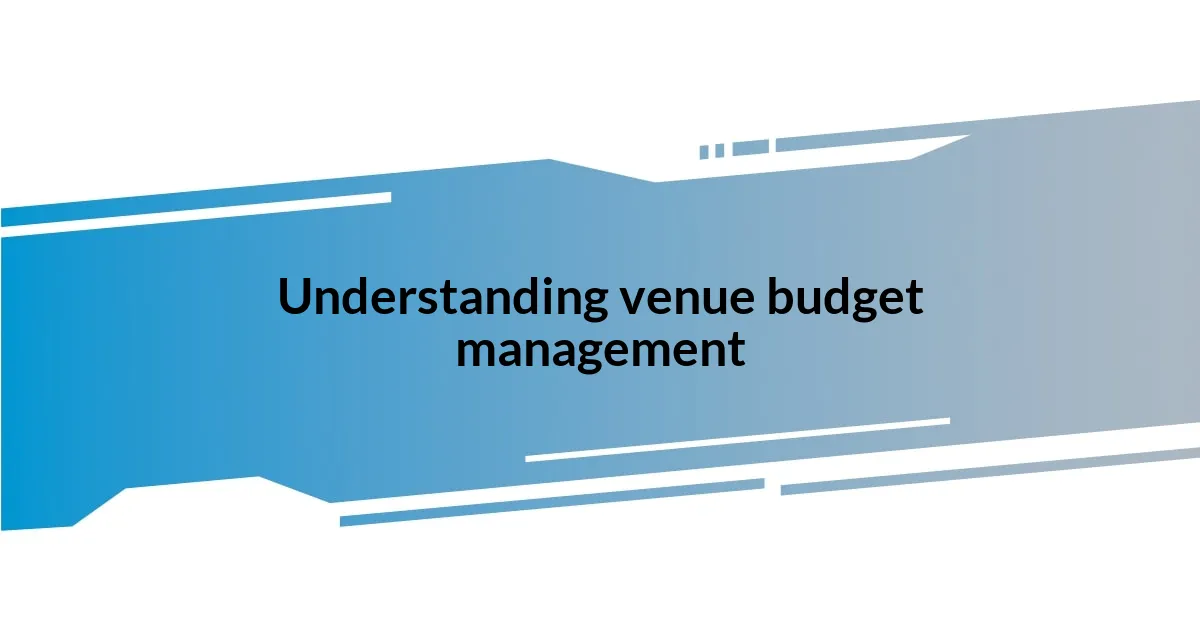
Understanding venue budget management
Managing a venue budget is a delicate balancing act. From securing the right location to accounting for unexpected expenses, every little detail counts. I remember a time when I underestimated the cost of utilities for an event; it turned my budget upside down, leaving me scrambling for funds. How can we better prepare ourselves to avoid such pitfalls?
In my experience, understanding the intricacies of venue budget management starts with a clear outline of all potential costs. This includes everything from rental fees to staffing and catering. I’ve found that creating a comprehensive spreadsheet can not only clarify expenses but also illuminate areas where you can save. Have you ever had a moment where you discovered a hidden cost that made you rethink your entire plan?
Involving all stakeholders early on is vital for transparency. I often gather feedback from team members and partners during budget discussions. This not only ensures that everyone is on the same page, but it also sparks conversations that can lead to innovative solutions. When was the last time a collaboration saved your budget? Finding value in collective insights can transform your budget management experience.
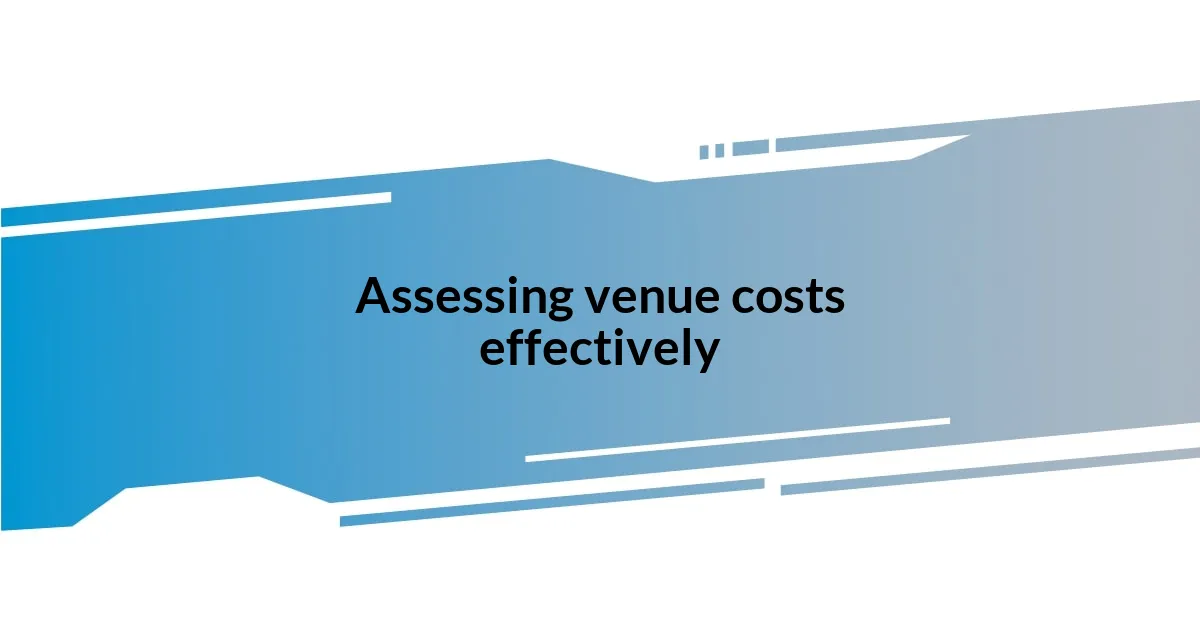
Assessing venue costs effectively
When it comes to assessing venue costs effectively, I’ve learned that a detailed breakdown of all possible expenses is crucial. One time, I overlooked the impact of logistics—like delivery and setup fees—resulting in a surprising hit to my overall budget. It’s those seemingly minor expenses that can add up and catch you off guard.
To avoid surprises and ensure accuracy, here’s what I always do:
– List all fixed costs: This includes rental fees, insurance, and deposits.
– Factor in variable costs: Think about things like catering, AV equipment, and overtime charges.
– Research additional fees: Some venues charge extra for late-night events or special services—always ask!
– Consult with venue staff: They often have insights about seasonal pricing or ongoing promotions.
– Review past events: Looking at previous budgets can highlight costs you might not initially consider.
By approaching venue costs with this holistic mindset, I’ve managed to navigate my budget more effectively and avoid the pitfalls that once led to unexpected expenses.
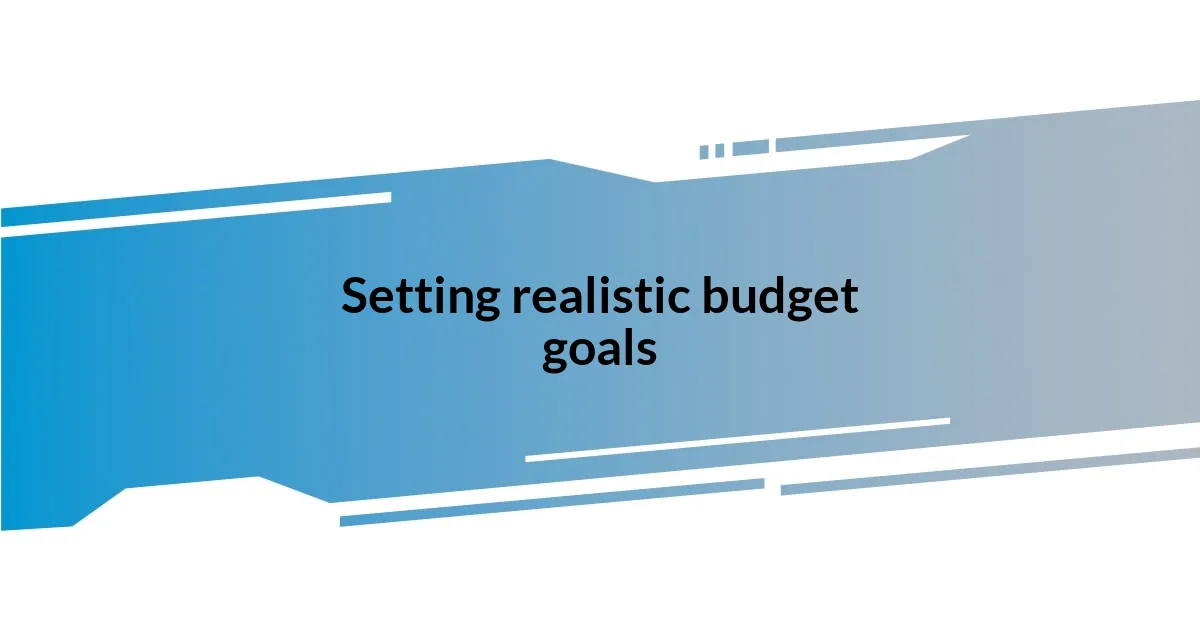
Setting realistic budget goals
Setting realistic budget goals is the foundation of effective venue management. I always remind myself that it’s easy to get carried away with dreams of extravagant setups and high-end services, but realistically assessing what I can afford keeps me grounded. For instance, during one event, I aimed for a lavish floral arrangement that ultimately forced me to cut costs elsewhere, leaving me feeling disappointed with my choices.
Breaking down my budget into achievable segments helps me visualize my financial landscape better. I find it effective to set small, realistic goals—like allocating 20% to venue rental, 30% to catering, and 10% to staffing. This way, I not only create a sense of structure but also celebrate the small wins when I find savings in each area. Have you ever felt the thrill of coming in under budget for a particular segment? It’s a rewarding experience that motivates me to keep researching cost-effective solutions.
It’s vital to build a cushion into your budget for contingencies. In my experience, I’ve learned the hard way that unexpected fees can arise, and having a buffer can save the day. For example, I once had a last-minute increase in guest count—which unexpectedly jacked up the catering costs. Luckily, I had set aside about 15% of my total budget for such surprises, which gave me the flexibility I needed to adapt and adjust without major stress.
| Goal Setting Approach | Advantages |
|---|---|
| Realistic Expense Allocation | Promotes structured budgeting |
| Cushion for Contingencies | Provides flexibility for unexpected costs |
| Small Achievable Goals | Encourages motivation through small wins |
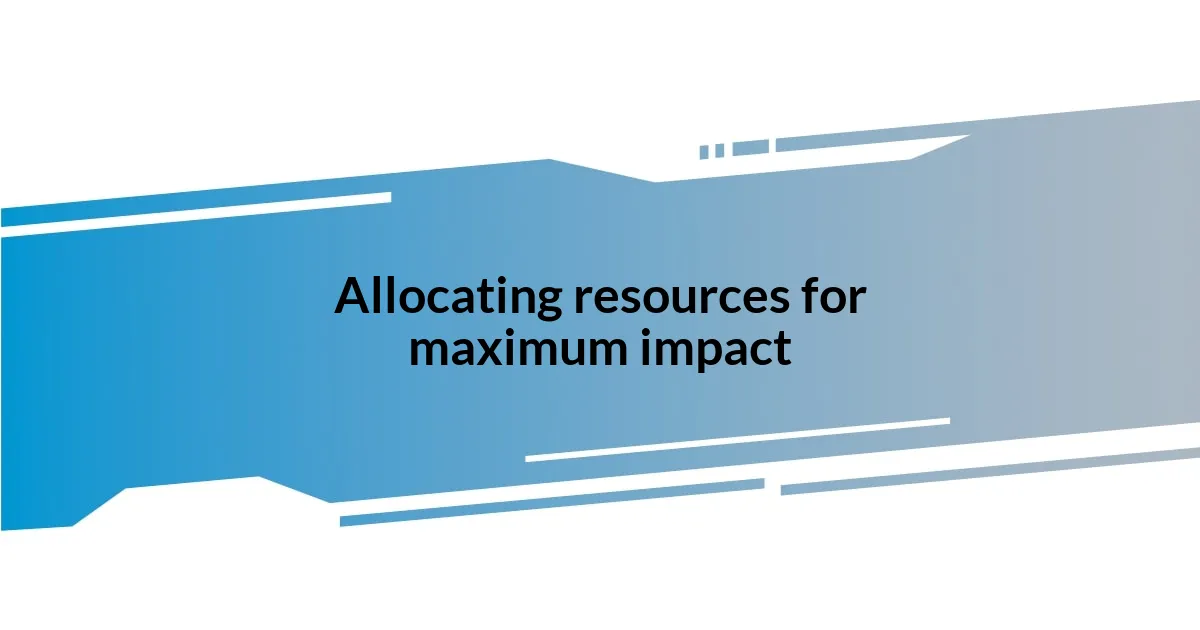
Allocating resources for maximum impact
Allocating resources for maximum impact requires a strategic mindset. I often find that prioritization is key; for example, when planning an event, I remember a time when I emphasized high-quality audiovisual equipment over flashy decor. The result? My attendees were captivated by the presentation, proving that sometimes it’s the fundamentals that leave a lasting impression. Have you ever walked away from an event after being wowed by the content rather than the look? I think that often rings true in our experiences.
In my journey of managing venue budgets, I’ve learned to make tough decisions about where to splurge and where to save. One particular event comes to mind when I opted for a more modest venue but invested in catering that left everyone raving for weeks. That memorable meal not only added warmth but also made the event feel special, reinforcing my belief that well-allocated resources amplify overall guest satisfaction. Isn’t it fascinating how those choices can shape the entire experience?
It’s essential to regularly reassess your resource allocation throughout the planning process. I remember a time when initial assumptions about guest attendance led me to either over-purchase or under-resource certain elements. By keeping an open line of communication with my team and remaining adaptable, I was able to pivot and reallocate funds to areas that needed it the most, such as enhanced safety measures, which became a hot topic. How often do we find ourselves needing to shift our strategies mid-course? Embracing flexibility has not only helped in the past but has become a crucial aspect of my approach to venue budget management.
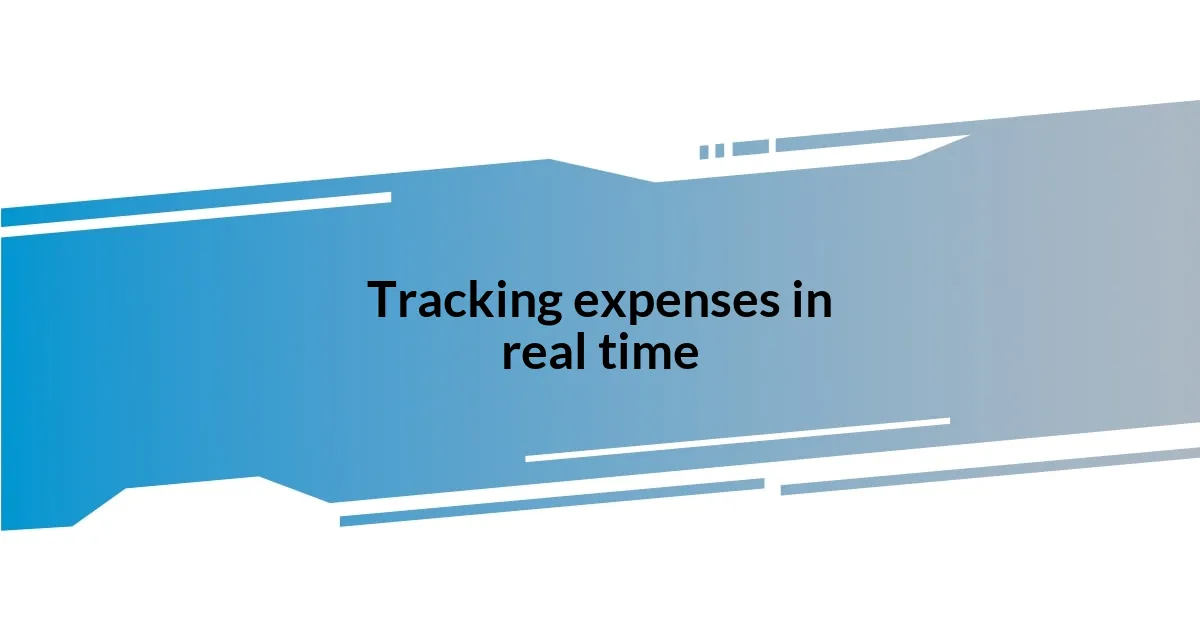
Tracking expenses in real time
Tracking expenses in real time has truly transformed how I manage venue budgets. I remember one event where I used a budgeting app that allowed me to update expenses instantly as I made purchases. What a game changer that was! Suddenly, I could see exact figures rather than estimations that left me feeling unsure. Have you ever felt that wave of relief when knowing your exact financial standing? It empowers you to make informed decisions without second-guessing every choice.
I’ve also discovered that setting up alerts for spending thresholds can help keep me on track. During a large conference I organized, I decided to set alerts for when certain categories reached 75% of their budget. This proactive approach not only prevented me from overspending but also encouraged me to rethink expenses sooner rather than later. Have you experienced that moment when you realize you’ve overshot your budget? Knowing I’d be promptly notified kept me focused, and I appreciated how it prompted me to pivot where necessary.
Regularly reviewing my expenses in real time helps me identify trends and track patterns that could easily go unnoticed. For instance, during my last few events, I noticed a recurring pattern of higher printing costs. By recognizing this trend early on, I could adjust for future events—this saved me a sizable chunk of change! Tracking expenses isn’t just about avoiding budget overruns; it’s a vital part of refining my strategy. How much more could we all save if we kept such a close eye on our spending?

Adjusting budgets based on feedback
Adjusting budgets based on feedback is a crucial aspect of my budgeting strategy. I recall an event where post-event surveys revealed that the networking opportunities provided were invaluable to attendees, yet the venue’s layout hindered interaction. Feeling disappointed, I quickly adjusted the budget for future events to ensure a more open, engaging space. Have you ever found yourself re-evaluating your choices based on feedback? It’s rewarding to see that insight shape your upcoming plans.
Another experience stands out when a key partner expressed concerns about catering options. Initially, I had allocated funds toward gluten-free alternatives, but after receiving feedback, I redirected that budget toward diverse cultural dishes that reflected our audience’s diversity. The response was overwhelmingly positive, and it solidified my understanding of the importance of listening to feedback. I’ve learned that sometimes we need to step out of our assumptions and adjust based on what our attendees truly desire.
I’ve also embraced the practice of holding debrief sessions after events, where team members share their perspectives. During one session, we uncovered a disparity between expected and actual guest satisfaction with our entertainment. By reallocating funds based on this feedback, we transformed future events, leading to memorable experiences for guests. How often do we miss out on these invaluable insights if we don’t seek them out? Adapting budgets based on feedback not only fosters connection but ultimately enhances the overall event experience.
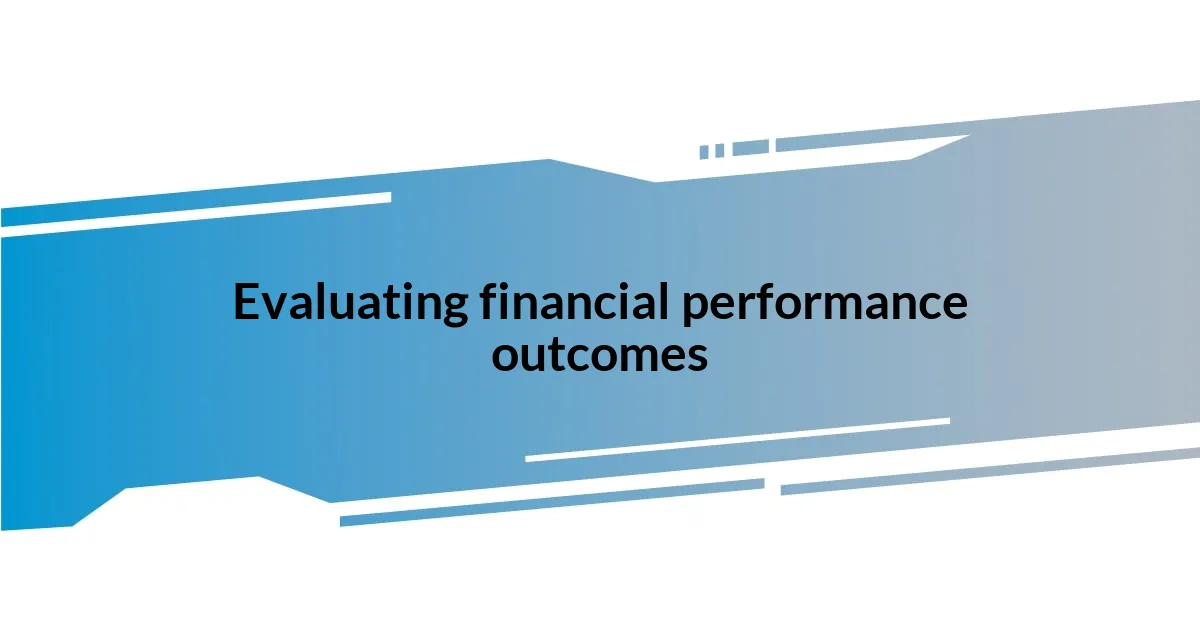
Evaluating financial performance outcomes
Evaluating financial performance outcomes is an essential part of my approach to venue budget management. Often, I dive into specific metrics like return on investment (ROI) and cost-per-attendee to gauge how effectively our funds are being utilized. For example, after one particularly successful gala, I calculated that every dollar spent yielded a 150% increase in donations—a figure that thrilled me. Have you ever taken a moment to genuinely analyze your expenditures and the outcomes? That realization can reshape your entire perspective.
In addition to ROI, I’ve learned to focus on qualitative outcomes, such as attendee satisfaction and engagement levels. After an event where we invested heavily in technology, I followed up with guests to understand if it truly enhanced their experience. The feedback was mixed, which highlighted the importance of not just crunching numbers but also listening to voices. Isn’t it fascinating that sometimes the most costly investments don’t resonate with attendees? This understanding informs how I allocate funds moving forward.
To bring it all together, I frequently visualize financial outcomes in reports, allowing me to identify patterns over multiple events. For instance, after noticing that events held in premium venues repeatedly resulted in lower overall satisfaction scores despite high costs, I re-evaluated my venue selection criteria. It’s moments like these that remind me to constantly seek improvement. How often do we overlook the bigger picture in our financial analysis? Embracing both the numbers and the stories behind them has truly enriched my strategic approach to budget management.